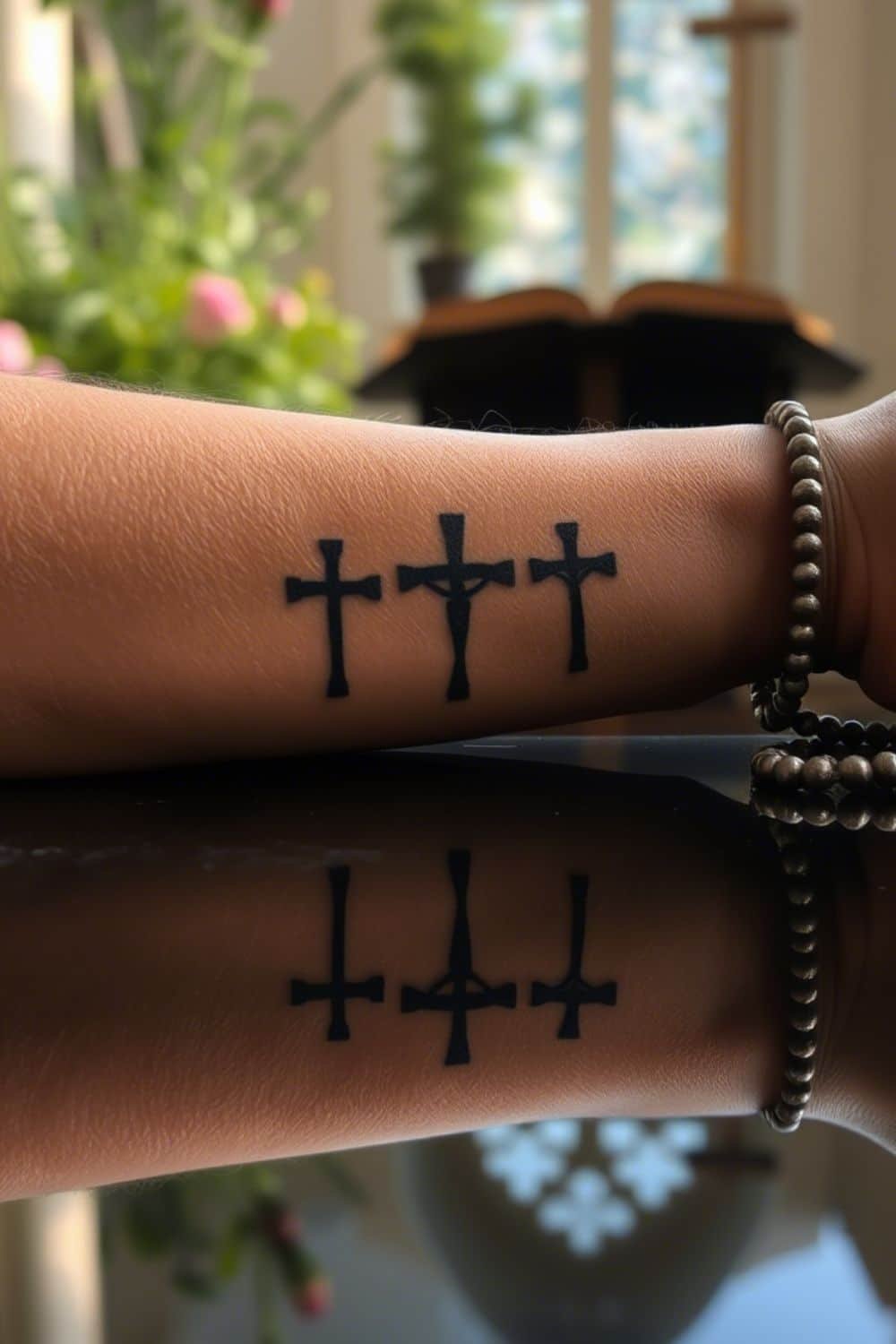Three crosses etched into skin tell stories that run deeper than ink. These aren’t just random religious symbols they carry weight, history, and profound personal meaning that’s been echoing through centuries of human faith and struggle.
When you see someone with three crosses tattooed on their body, you’re witnessing one of Christianity’s most powerful visual narratives. The imagery goes straight back to Calvary, where Jesus Christ was crucified alongside two thieves. It’s raw. It’s real. And it captures one of the most pivotal moments in Christian theology.
The Biblical Foundation That Started It All
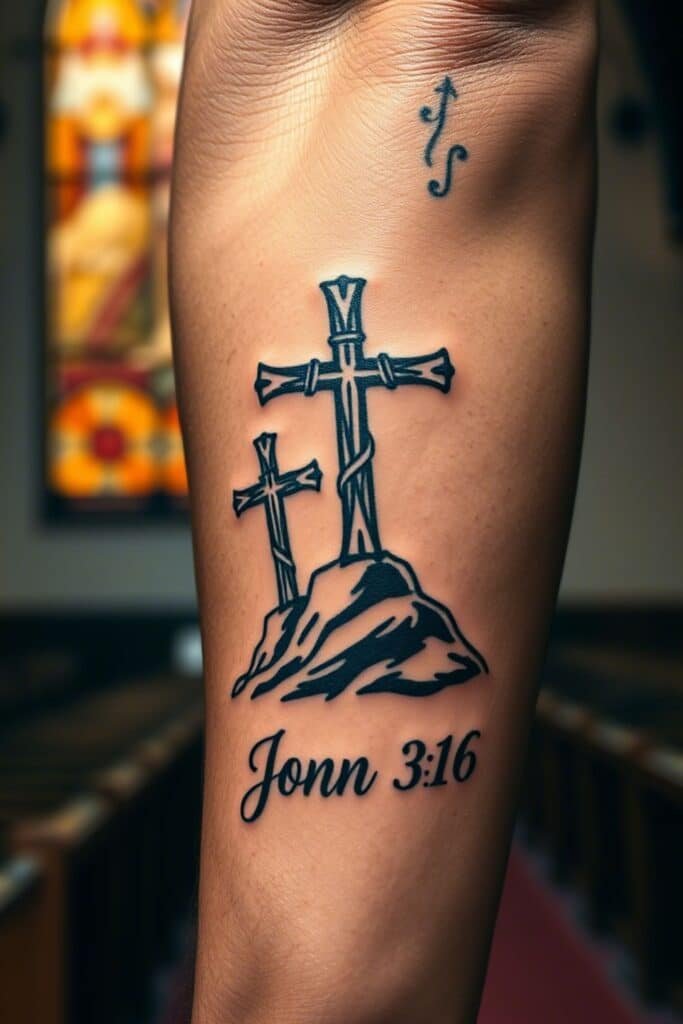
The story begins on a hill called Golgotha. Three men hung on wooden crosses, but only one would change the course of human history forever. Luke’s Gospel paints the scene with unflinching detail Jesus positioned between two criminals, one mocking, the other seeking redemption.
This wasn’t just execution. It was cosmic theater. The thief on the right recognized something divine in the man beside him. “Remember me when you come into your kingdom,” he pleaded. Those words became the foundation for millions of three-cross tattoos worldwide.
The symbolism runs deeper than most people realize. Each cross represents a different path, a different choice made in humanity’s darkest hour. The left cross often symbolizes rejection and mockery. The center cross embodies sacrifice and redemption. The right cross represents repentance and salvation.
Modern Interpretations That Go Beyond Scripture
Today’s three-cross tattoos aren’t always strictly biblical. Some people use them to represent the Holy Trinity Father, Son, and Holy Spirit. Others see them as symbols of faith, hope, and love. The beauty lies in personal interpretation.
Prison culture has embraced three crosses differently. Behind bars, these tattoos often mark significant spiritual transformations. An inmate might get three crosses after finding religion, marking their rebirth. It’s become a visual testimony of change, hope, and newfound purpose.
Military personnel frequently choose three-cross designs too. For them, the crosses might represent fallen comrades, divine protection, or the weight of service. Each cross becomes a memorial, a prayer, or a promise carved into flesh.
Design Variations That Tell Different Stories
Not all three-cross tattoos look the same. Some feature three identical crosses standing tall on a hill. Others show a larger center cross flanked by smaller ones. The variations matter they shift meaning and emphasis in subtle but significant ways.
Celtic influences have crept into modern designs. Three Celtic crosses create entirely different energy. They blend Christian symbolism with ancient Celtic spirituality, representing the intersection of faith traditions. The intricate knotwork adds layers of meaning about eternal life and interconnectedness.
Minimalist approaches strip away everything except pure symbolism. Three simple lines forming crosses. No shading, no elaborate details. Just raw, honest faith expressed in its most basic form. These designs often pack more emotional punch than their ornate counterparts.
Placement Psychology and Hidden Messages
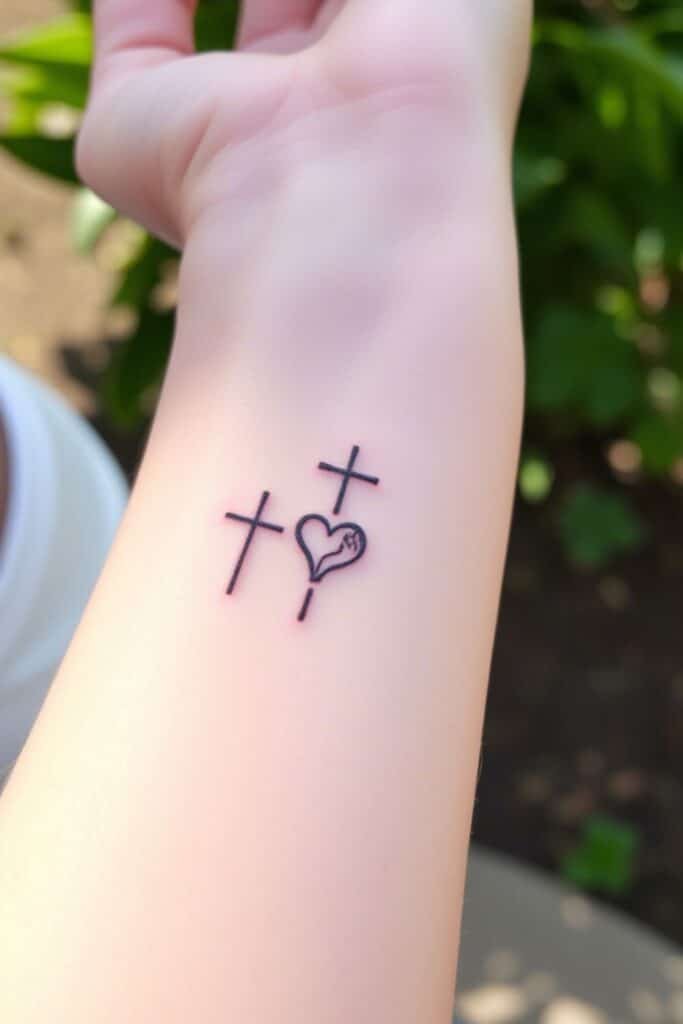
Where someone places their three-cross tattoo speaks volumes about their relationship with faith. Chest placements keep the crosses close to the heart literally and figuratively. These are deeply personal expressions, often hidden beneath clothing until the wearer chooses to reveal them.
Forearm placements make bold statements. They’re visible, public declarations of faith. The wearer isn’t hiding their beliefs they’re advertising them. It’s spiritual confidence worn on the sleeve, quite literally.
Back tattoos tell different stories entirely. Three crosses across shoulder blades or down the spine suggest that faith supports and strengthens the bearer. The placement implies that religious conviction provides backbone, structure, and support through life’s challenges.
Cultural Variations Across Different Communities
Hispanic communities have embraced three-cross tattoos with particular enthusiasm. These designs often incorporate additional elements like roses, doves, or Spanish script. The crosses become part of larger narratives about family, heritage, and spiritual identity.
In African American communities, three crosses sometimes appear alongside other powerful symbols. Names of lost loved ones, dates of significance, or inspirational quotes frame the crosses. The tattoos become complex memorial pieces that honor both faith and family.
Native American interpretations blend crosses with traditional tribal elements. Feathers, dreamcatchers, or animal spirits surround the crosses. These designs represent the complicated relationship between Christianity and indigenous spirituality conflict, acceptance, and synthesis all captured in ink.
The Psychological Impact of Sacred Ink
Getting three crosses tattooed isn’t usually an impulsive decision. People often wrestle with the choice for months or years. The permanence of tattoos combined with the sacred nature of the symbol creates genuine psychological weight.
Many people report feeling different after getting their three-cross tattoo. Not just physically, but spiritually and emotionally. The ink becomes a constant reminder of commitments made, faith embraced, or transformations undergone. It’s wearable accountability.
Some psychological studies suggest that religious tattoos can actually strengthen faith. The visible reminder creates daily opportunities for reflection and recommitment. Every glimpse in the mirror becomes a moment of spiritual connection.
Historical Context Beyond Christianity
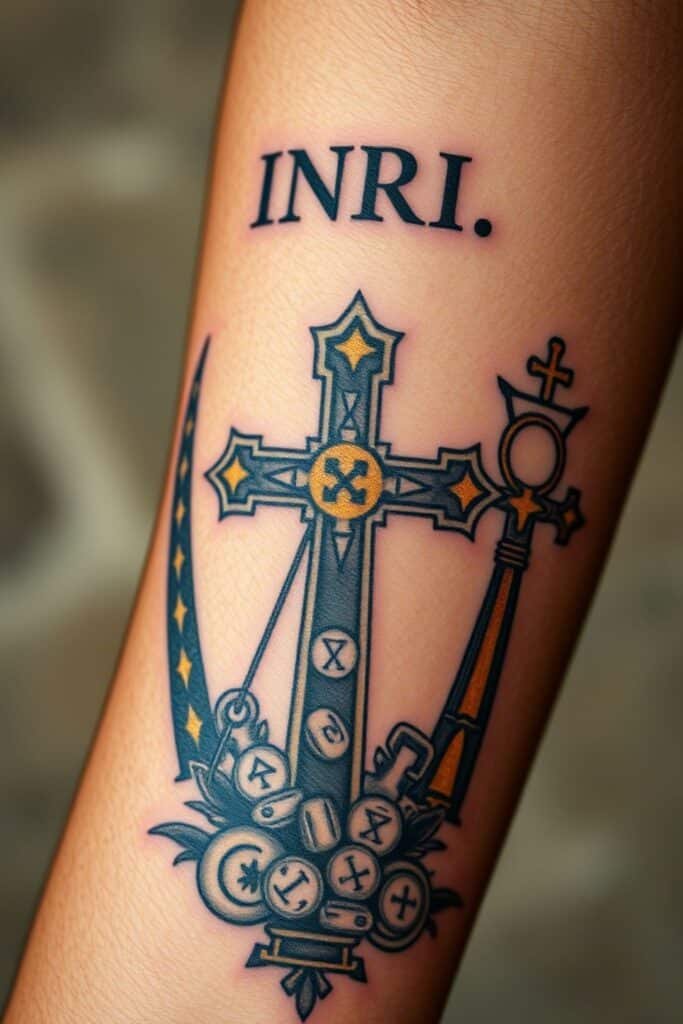
While three crosses are predominantly Christian symbols, similar groupings appear across cultures. Ancient Celtic traditions spoke of triple goddesses. Hindu practices reference three primary deities. The number three carries universal spiritual significance that transcends single religious traditions.
Medieval Christian art frequently depicted three crosses. These weren’t just biblical illustrations they were teaching tools for largely illiterate populations. The visual impact of three crosses could communicate complex theological concepts without requiring literacy.
Renaissance artists elevated the three-cross motif to high art. Paintings, sculptures, and frescoes featuring Calvary’s three crosses became central to Christian artistic expression. Modern tattoo artists draw inspiration from these classical representations.
Contemporary Controversies and Considerations
Not everyone embraces three-cross tattoos positively. Some conservative Christians view any tattoo as biblical violation, regardless of religious imagery. Leviticus 19:28 creates ongoing theological debate about body modification within faith communities.
Prison associations sometimes complicate the symbolism. Three crosses might indicate gang affiliation rather than spiritual conviction. Context matters enormously in interpreting these tattoos, and assumptions can be dangerous.
Cultural appropriation concerns arise when non-Christians adopt Christian symbols for purely aesthetic reasons. Three crosses carry profound meaning for believers, and casual use can feel disrespectful or trivializing.
The Artist’s Perspective on Sacred Imagery
Tattoo artists approach three-cross designs with unusual reverence. Many report feeling extra responsibility when creating religious tattoos. They’re not just crafting art they’re helping people express their deepest beliefs and commitments.
Technical challenges make three-cross tattoos particularly demanding. Straight lines are harder to execute than curved ones. Symmetry requires precision. Simple designs leave no room for error every line must be perfect.
Experienced artists often counsel clients extensively before beginning three-cross tattoos. They explore motivations, discuss placement options, and ensure the client understands the permanence and visibility of their choice.
Personal Stories Behind the Ink
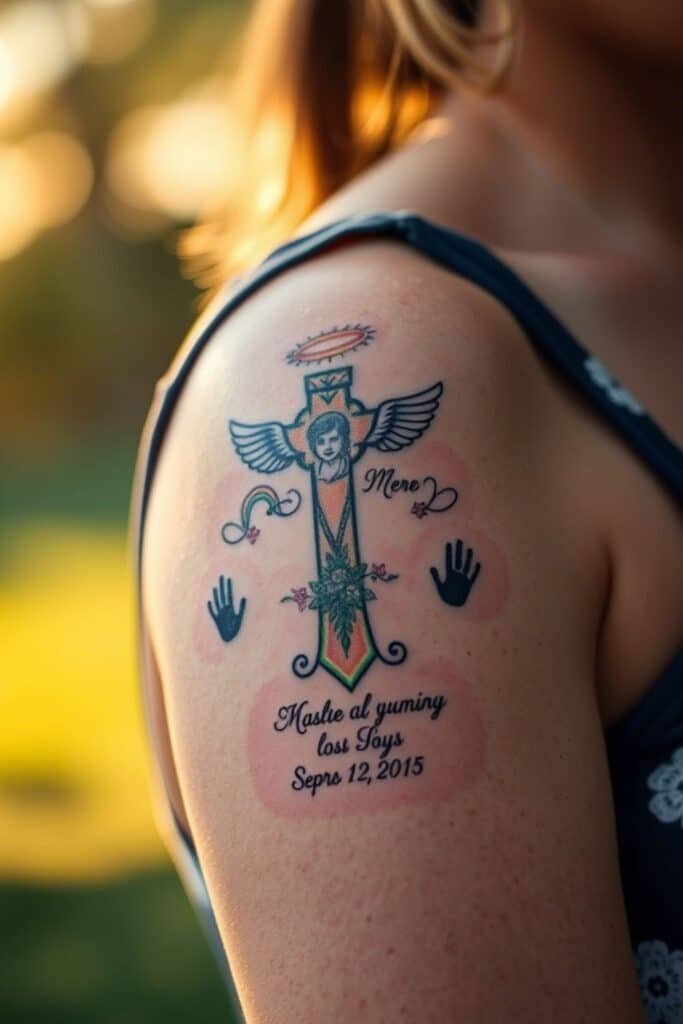
Sarah got her three crosses after surviving cancer. Each cross represents a different aspect of her journey diagnosis, treatment, and recovery. The tattoo marks not just survival, but spiritual transformation through suffering.
Marcus chose three crosses to honor his grandfather, father, and son. Three generations of faith expressed in permanent ink. The crosses connect him to past, present, and future simultaneously.
Maria’s three crosses include the names of miscarried children. Each cross memorializes a lost baby while affirming faith in eventual reunion. The tattoo transforms grief into hope, loss into lasting love.
Maintenance and Aging of Sacred Tattoos
Three-cross tattoos age differently than other designs. Simple black lines tend to blur less than complex images. However, straight lines can become wobbly over time, potentially affecting the tattoo’s spiritual impact for the wearer.
Touch-ups often carry special significance for religious tattoos. Refreshing three crosses isn’t just aesthetic maintenance it’s spiritual renewal. Many people treat touch-up appointments as opportunities for reflection and recommitment.
Laser removal of three-cross tattoos raises complex emotional issues. People considering removal often struggle with questions about faith, commitment, and identity. The process becomes psychological as much as physical.
Future Trends in Religious Tattoo Art
Three-cross tattoos continue evolving artistically. Watercolor techniques create ethereal, spiritual effects. Geometric approaches blend ancient symbols with contemporary aesthetics. 3D techniques make crosses appear to rise from skin.
Technology might soon allow interactive religious tattoos. Imagine three crosses that could display prayers, play hymns, or connect to faith-based apps. The intersection of spirituality and technology opens unprecedented possibilities.
Virtual reality might change how people design their three-cross tattoos. Clients could visualize their tattoos in realistic settings before committing to permanent ink. This technology could reduce regret and increase satisfaction with religious body art.
Conclusion: More Than Skin Deep
Three-cross tattoos represent far more than decorative body art. They’re declarations of faith, markers of transformation, and permanent reminders of life’s most significant moments. Each set of crosses tells a unique story while connecting to universal themes of sacrifice, redemption, and hope.
Whether rooted in biblical tradition, personal experience, or cultural heritage, these tattoos carry profound weight. They transform skin into scripture, bodies into testimonies, and individuals into walking expressions of sacred conviction.
The meaning of three-cross tattoos ultimately lies not in universal interpretation, but in personal significance. Each wearer brings their own story, their own faith, and their own understanding to these ancient symbols. In doing so, they participate in a tradition that spans centuries while creating something entirely their own.

Lex memn is a passionate tattoo artist and writer with 3 years of experience in the tattoo world. Dedicated to inspiring and guiding people through creative designs and meaningful tattoo ideas, Lex memn shares their expertise with readers. Explore their work and passion for ink at TifoMags!

